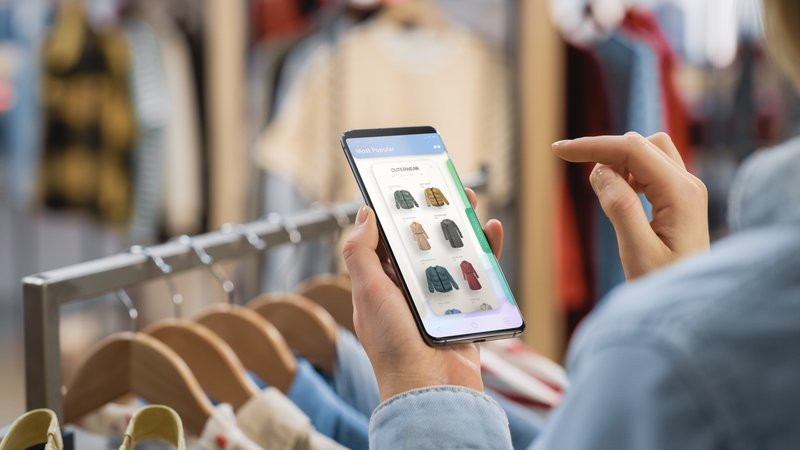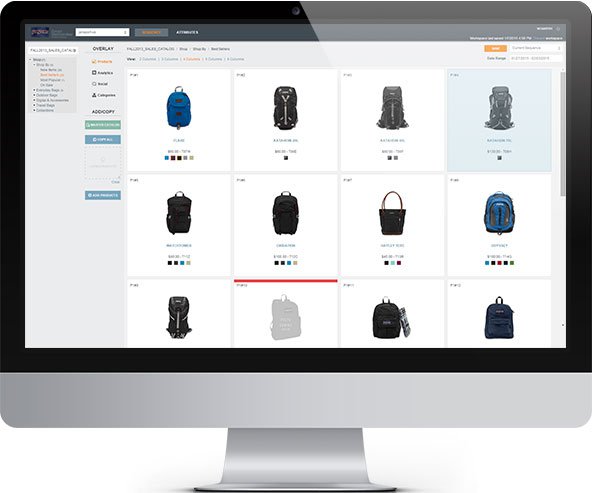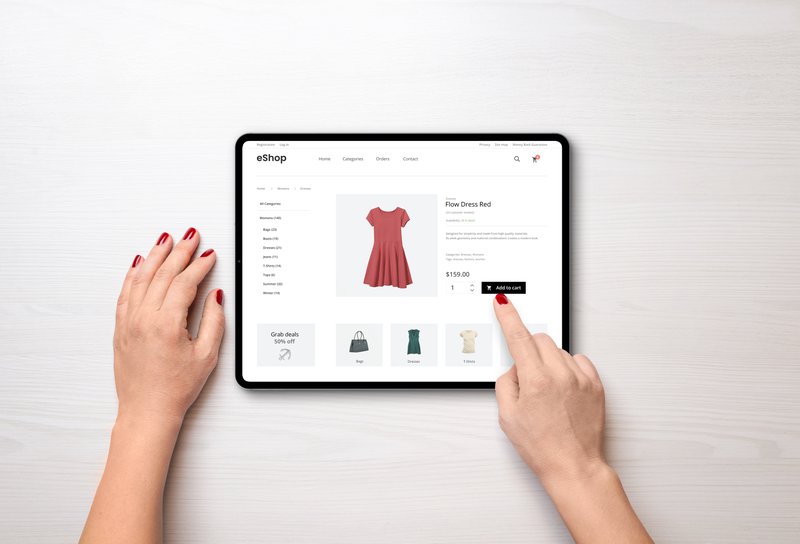eCommerce is an increasingly competitive industry. After all, with over 26.5 million eCommerce sites worldwide as of 2023, more companies are vying for customer attention than ever. To make your B2B website stand out, boosting site merchandising performance is critical.
A well-planned merchandising strategy enables you to enhance the visual appeal of your website while making it easier for shoppers to find your products. In turn, this can help you improve customer engagement and increase conversion rates. But before you begin your eCommerce merchandising initiatives, you need to understand the process behind it.
This guide looks at the different facets of site merchandising, from the use of analytics to product management best practices. Let’s get started.

Unraveling the Complications of Site Merchandising
There’s both an art and a science to showcasing products in a digital space. It demands a nuanced understanding of consumer behavior and market trends, as well as the dynamic landscape of site merchandising.
Merchandising is more than just putting products on a webpage. It also includes a number of complex tasks. For instance, site merchandisers must balance product visibility with strategic placement. Product listings must also be accurate and their information up to date.
What’s more, the product listings themselves should be compelling narratives. You want item descriptions to engage audiences while also clearly communicating the brand’s overarching messaging strategy. By telling a compelling story about each product, merchandisers create a connection with customers that enhances the perceived value of the offerings.
To ensure the success of site merchandising strategies, companies must monitor inventory and sustain the right stock levels to meet client demand. They must also make sure that the stock counts reflected on the site are accurate to keep fulfillment processes as efficient as possible.
In addition, merchandisers must stay ahead of the curve. As such, they must diligently monitor any shifts in both consumer preferences and industry trends. By continually adapting, they can keep their product offerings relevant in today’s dynamic market landscape.
Finally, eCommerce merchandisers must create strategies that align with the brand’s overall positioning. They develop a brand voice and imagery and then ensure it’s used across various customer touchpoints.
All these tasks enhance product management. Of course, merchandisers must also be able to identify and address challenges in product information management (PIM) that may arise as they execute their strategies.

Pinpointing Site Merchandising Issues To Resolve
Clearly, site merchandising is multifaceted. So, it’s not surprising that it comes with challenges that demand attention and strategic solutions. Be it dealing with large product selections or organizing website displays, analysts must approach each hurdle with creativity and technical know-how.
But some merchandising challenges can elude even the most seasoned analysts. For instance:
Merchandising Non-Compliance
It takes multiple teams to maintain an eCommerce site. But if there are no established branding guidelines, standards, or strategies within the organization, your site merchandising initiatives can fail. This can lead to an inconsistent brand image, a diminished user experience, or legal risks.
Inability To Meet Client Needs
B2B buyers often want to examine products closely. Because eCommerce can’t provide a sensory experience, site merchandisers must compensate by providing details about each product. But if you don’t have a clear understanding of how your buyers think, you won’t be able to give them the information they need to make a purchasing decision.
Rapidly Changing Market Landscape
Like any other industry, the B2B landscape constantly shifts. Buyers in the industry once relied on printed catalogs and direct negotiations; but now, 83% of B2B buyers prefer to order through eCommerce. In addition, 73% now say they want a personalized B2C-like experience. Changes like these may make it difficult for eCommerce merchandising experts to adapt.
Poor Data Quality
If you’re using inaccurate, incomplete, or outdated datasets, you won’t yield helpful insights into site merchandising performance. In fact, merchandisers might struggle to present their products effectively, which will dampen the overall success of their eCommerce initiatives.
Incorrect Data Interpretation
Interpreting customer behavior, market trends, or product performance incorrectly can lead to misguided merchandising strategies and poor decision-making. This can negatively impact your clients’ shopping experience.
Addressing these challenges is difficult for eCommerce merchandising analysts who already have their hands full with day-to-day tasks. To remedy this, they must leverage product intelligence. This approach uses data-driven insights to pinpoint potential site merchandising issues and determine the best solution.

How Product Intelligence Empowers Every Merchandiser
Product intelligence is the process of gathering and analyzing data related to customer interactions with a product. It uses both customer data and operational data to gain insights into site performance. As such, this process drives innovation in product development and site merchandising optimization to enhance the overall experience.
To give you a more concrete idea of how you can utilize product intelligence, let’s discuss some of its components.
Product Analytics
Product analytics focuses on the collection and analysis of data related to product use and performance. It often encompasses customer interactions, feedback, and operational metrics. As a result, you gain insights that guide product improvements, feature enhancements, or merchandising strategies.
Using product analytics, you can:
- Understand what clients want and how they browse.
- Uncover patterns in user data to anticipate changes in customer preferences.
- Assess your conversion funnel to address any pain points in the customer journey.
- Measure the impact of marketing efforts on product sales.
- Conduct A/B tests on product placements or product versions to assess their impact.
Product Merchandising
Product merchandising is the strategy behind how you present and promote products to influence buying decisions. The process often analyzes sales data, customer preferences, and market trends to understand what products resonate with customers and how they respond to various merchandising strategies. Businesses can then hone their product placement, pricing, and promotional efforts.
For instance, you might focus on the uniqueness of your products. Selling products in a market saturated with options can be a challenge. Rather than convince B2B buyers that you offer the best products on the market, you should instead home in on what makes your product different. If you specialize in organic cleaning solutions, you can emphasize how eco-friendly and sustainable your products are.
Also, be sure to provide high-resolution images of your products. After all, no consumer will pay for something they haven’t seen yet. Consider offering 360-degree photos or an interactive way to view the photos, such as through virtual reality. You can also leverage visual merchandising strategies to improve the browsing experience.

Ratings Management
In ratings management, you monitor and manage customer ratings and reviews of products. This enables merchandising analysts to better understand product strengths and weaknesses.
What’s more, ratings provide social proof and help consumers make informed decisions. In fact, 93% of consumers say reviews can affect their shopping choices. Posting reviews, both positive and negative, can also help you strengthen customer loyalty and brand perception.
Use positive ratings to highlight your popular products. But don’t be afraid of negative feedback, as it can reveal ways you might improve your products or eCommerce site.
Inventory Management
Inventory management involves overseeing the levels and availability of products in stock. This requires analyzing sales trends, demand forecasting, and supply chain efficiency. By taking the time to do this, merchandising analysts can:
- Maintain cost efficiency by making sure inventory levels align with actual demand
- Prevent overstocking and reduce holding costs
- Ensure timely order fulfillment and prevent stockouts
- Optimize warehouse space
- Improve the management of inventory turnover
Using Smart Merchandiser To Connect Siloed Information
Site merchandisers often find themselves analyzing product and consumer data day in and day out to make informed decisions. But these datasets often come from multiple platforms, making it challenging to consolidate the information. This is where Smart Merchandiser proves useful.
Smart Merchandiser is feature-rich, online merchandising software built to simplify how businesses manage their digital storefronts. It enables merchandisers to make the most of their product intelligence with tools like Analytics Overlay™, which visualizes data like product views, sales revenues, and abandonment rates. It also supports analytics tools you may already use, such as IBM Analytics, Google Analytics, and Omniture.
What’s more, the platform’s Color Management tool lets site merchandising experts arrange the color sequence of products to promote items in certain colors. This makes it easy to display specific variations of items by season, popularity, or inventory level. Similarly, an Attribute Management tool enables users to manage products by attributes such as size, material, weight, design, and category.

Smart Merchandiser also reinforces ratings management through its integrated social media tracking feature. This means merchandisers can capture consumer interactions outside your site. These include likes on Facebook and X (formerly Twitter), as well as ratings and reviews on platforms such as BazaarVoice and Power Reviews.
Another key feature is Smart Merchandiser’s built-in inventory reporting module, which shows your stock levels in real time. You can easily see what items you have on hand, which ones are running low, and which ones aren’t selling.
Simplifying Product Promotions and Brand Initiatives
The dynamic nature of the B2B landscape can make it hard to promote products or meet specific brand goals. Aside from changing consumer preferences and intense market competition, merchandisers often get caught up in the guesswork involved in creating processes that work. Don’t worry—the following strategies can make things easier.
Active Promotion Tracking
Monitoring promotions is a critical part of successful site merchandising strategies. It enables you to assess ongoing promotions in real time so you can promptly detect any discrepancies in your campaign. Real-time monitoring also prevents overlaps with other promotions. Plus, it’s pivotal in allowing merchandisers to react to negative trends and measure specific marketing activities.
By using tools like Smart Merchandiser, you can execute comparative promotion tracking. For instance, you can assess the products you’re putting on promotion against products that aren’t being promoted. You can also evaluate the rate of selling for different inventory items to see when you might need to restock or place certain products on clearance sales.
In addition, the platform has an upcoming promotion tracking and optimization feature. This promotion overlay helps users track the performance of campaigns and determine how to improve them.
Reports Tracking
It’s also critical to continually analyze reports on other aspects of your site merchandising campaign. This includes tracking key performance indicators (KPIs) such as website visits, new vs. returning visitors, conversion rates, top landing pages, abandoned cart rates, and browsing time.
Doing so will enable you to see the bigger picture when it comes to the performance of your promotional campaigns. For example, you can identify specific strategies or elements of each campaign that contributed to its success. This could include particular messaging or imagery that resonated with your target audience.
Reports tracking gives you a comprehensive overview of the return on investment (ROI) for your promotions. These reports can also provide insights into how your different audience segments respond to promotions.
When it comes to touchpoints, reports tracking can help you understand customer preferences. This makes it easier to know where you should focus your campaigns next. And perhaps most importantly, tracking reports can foster a culture of continuous improvement so you can enhance your strategies over time.

Become an Analytics Expert With Smart Merchandiser
eCommerce merchandising requires more than just basic insights; it demands a comprehensive understanding of product data and a mastery of analytics. Of course, that doesn’t mean you need a formal degree—or even a crash course—in data analytics to decipher product intelligence. With tools like Smart Merchandiser, you can gain actionable insights from your product data reports.
From decoding product analytics to utilizing site merchandising information, we explore how this platform can be an indispensable asset for companies who want to make easy use of their product data.
Harnessing the Power of Site Analytics
Site analytics provides a wealth of information regarding user behavior and engagement patterns on your website. It often requires site merchandisers to look into data such as:
- Journey Mapping: This identifies entry and exit points, key touchpoints, and potential bottlenecks to understand how visitors navigate through site pages.
- Traffic Source Analysis: This helps you understand which channels drive the most visitors and which ones yield the highest conversions.
- Page Performance Metrics: These metrics identify both high-performing pages and those that need improvement by analyzing bounce rates and average time spent on pages.
- Site Speed Optimization: This focuses on site loading times and page speed. As a result, you can pinpoint unnecessary scripts and images that can be improved.
- Search Engine Optimization (SEO): Site analytics can also help you assess your SEO strategies. It identifies which keywords are driving traffic, monitors search engine rankings, and analyzes click-through rates from search results.
Using Smart Merchandiser, you can map Adobe Analytics into each product instead of manually checking the reports. This lets you see each product’s performance based on your selected KPIs.
The platform also has a heat map to help you understand how your website visitors are interacting with product listing pages. Such data is critical to figuring out where to display certain products for maximum discoverability.
Building Customer Experience Through KPIs
Taking a close look at KPIs is instrumental in refining and enhancing the overall customer experience. For instance, doing this enables you to:
- Regularly measure customer satisfaction with a particular product, service, or interaction so you can address pain points quickly.
- Understand what makes clients stay by comparing customer retention rates and then identifying what strategies you implemented to achieve high retention rates.
- Perform sentiment analysis on customer reviews to gain a better understanding of the customer experience.
- Compare your site’s performance against industry benchmarks to identify what areas need improvement.
- Analyze past customer behavior and preferences to proactively anticipate and address changes in consumer needs.
Smart Merchandiser enables users to perform these actions by using its analytics dashboards, which combine your important KPIs in one hub. This way, you can track, analyze, and compare relevant data as conveniently as possible.
Controlling Your Product Category Assortments
Assortment planning on eCommerce sites can be difficult due to factors such as seasonal fluctuations in demand, supply chain considerations, data complexity, and varying customer preferences. But taking pains to do this can help you narrow down the product range you’re showcasing to maximize consumer interest as they browse your site.
To effectively control your product category assortments, it’s important to identify your current category structure. Then, leverage analytics to determine which products will perform well in specific categories. From there, you can regularly review and update assortments by considering customer feedback and monitoring user interactions.
Smart Merchandiser features a unique overlay that displays the number of categories each product has been merchandised within. This simplifies the process of managing product variations by providing a cross-reference of all associated categories for each product. You can then remove unnecessary categories without the need to navigate to each specific category individually.

Curating Promotion Collections From Your Product Management Catalog
There’s more to launching promotions than randomly picking products to put on sale or showcasing a new item that you want your customers to know about. Curating promotion collections requires merchandisers to strike a balance between driving sales and maintaining a cohesive brand image.
In addition, promotions should be carefully planned according to the interests and wants of your audience. Use these practical tips to get started:
Understand Your Audience
Analyze your audience demographics and preferences. Try to consider the needs of your B2B clients and craft promotions that meet their business needs.
Align Promotions With Business Goals
Define why you’re creating a promotion collection in the first place. Do you want to increase sales, expand your market share, foster client relationships, or simply clear your excess inventory? Whatever the case, make sure your campaign aligns with your goals.
Select Products Strategically
When choosing products for your promotions, consider the needs of your audience and the relevance of each product to the promotion theme. Try to highlight products that complement each other, as this encourages buyers to explore your other offerings.
Optimize Product Narratives
Before publishing your catalog, make sure your product narratives clearly explain the value and benefits of the products you’re promoting. This way, you can provide the right context and set the expectations for your consumers.
Ensure Consistent Visual Branding
Use high-quality images and graphics that match your brand’s overall aesthetic. Also, choose a consistent visual theme for your collection. This is crucial to maintain a cohesive visual identity and build an instantly recognizable brand.
Monitor and Adjust
Regularly assess the performance of your promotions, analyze relevant metrics, and be prepared to make adjustments. This dynamic approach lets you adapt to changing market conditions and continuously improve your B2B site merchandising efforts.

Building Superior Category-Based Shopping Opportunities
The key to delivering an exceptional shopping experience lies in how effectively you organize product categories. A well-structured, visually appealing eCommerce catalog makes for a more engaging and fuss-free customer journey. As a result, it elevates user satisfaction, which can drive higher conversions and foster brand loyalty.
These strategies can help you make the most of category-based shopping opportunities:
- Choose effective category page titles. With user search intent in mind, opt for descriptive, engaging, and relevant titles. Perform keyword research to pinpoint terms that will resonate with your audience.
- Optimize metadata. Refine title tags, meta descriptions, and heading tags. These are among the first things consumers will see in search results and can immediately communicate what your company offers and attract more customers.
- Create a structured site hierarchy. Establish a logical pathway from broader categories (smartphones, laptops) to more specific product groups (Android and iOS, Windows and Mac).
- Make navigation intuitive. Implement clear menus and easily accessible links to help users find what they need without unnecessary clicks. It also reduces friction and encourages further browsing on your site.
- Group products thematically. Group products according to specific use cases, common attributes, or seasonal themes. This lets you present related items together, so it’s easier for users to find complementary products.
- Make product options searchable and filterable. Provide a search engine and filter options. This lets customers quickly locate specific items based on criteria like color, price, and size.
- Implement personalized recommendations. Use algorithms or data analytics to personalize recommendations based on a customer’s browsing behavior or purchasing history. Buyers can then find relevant products without having to go through your entire catalog.
Ensure Site Merchandising Success With Smart Merchandiser
There’s no doubt that site merchandising is complex and requires companies to have a clear understanding of managing products on eCommerce sites. But with the right data and tools at your disposal, you can navigate the process with ease and ensure the success of your campaigns.
Are you ready to revolutionize your site merchandising strategy? Unlock the power of your product data with Smart Merchandiser. To learn more about how our platform drives eCommerce efficiency, request a demo today. We’re more than happy to walk you through our platform’s features.




